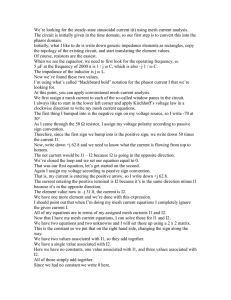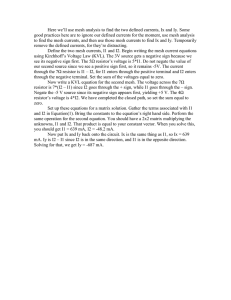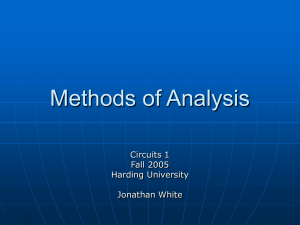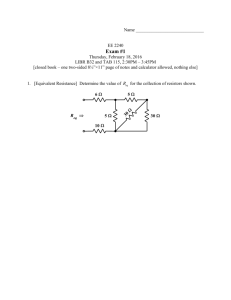Document 13660889
advertisement
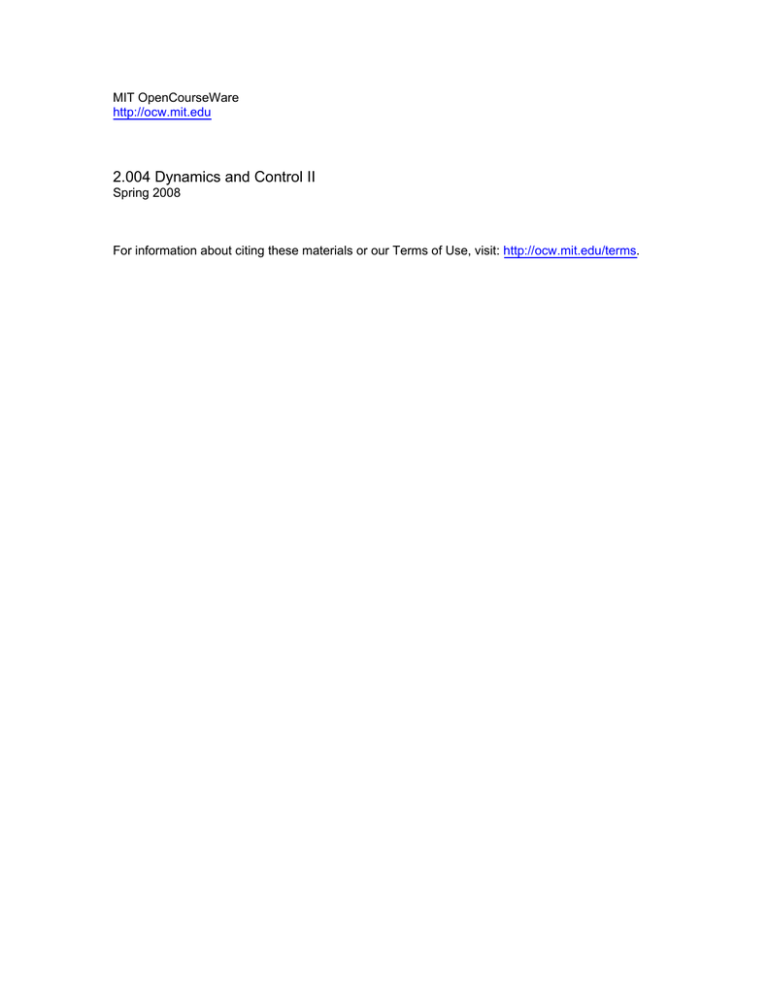
MIT OpenCourseWare http://ocw.mit.edu 2.004 Dynamics and Control II Spring 2008 For information about citing these materials or our Terms of Use, visit: http://ocw.mit.edu/terms. Massachusetts Institute of Technology Department of Mechanical Engineering 2.004 Dynamics and Control II Spring Term 2008 Lecture 71 Reading: • Nise: Sec. 2.4 1 Transfer Function Generation by Simplification Example 1 Find the transfer function for a “lead-lag” compensator C 1 (b ) (a ) V s (t) R + 1 R - C 2 2 vo (c ) Draw as (a ) Z + V s (s ) (b ) 1 Z - 2 (c ) where 1 R1 � R1 = C1 s R1 C1 s + 1 1 R2 = � R2 = C2 s R2 C2 s + 1 Z1 = Z2 1 c D.Rowell 2008 copyright � 7–1 H (s ) = V o(s ) V s(s ) Using the voltage divider formed by Z1 and Z2 Vo = = Z2 Vs Z1 + Z 2 ( R2 CR22s+1 ) Vs ( R1 CR11s+1 ) + ( R2 CR22s+1 ) R2 R1 C1 s + R2 = Vs R1 R2 (C1 + C2 )s + (R1 + R2 ) H(s) = Vo (s) R2 R1 C1 s + R2 = Vs (s) R1 R2 (C1 + C2 )s + (R1 + R2 ) Example 2 Find the transfer function VL (s) I(s) H(s) = for the circuit: R (a ) i1 I (s ) R 2 i 1 2 L V C We note that VL (s) = ZL i2 (s) = Lsi2 (s) Combine elements to let 1 1 = R1 + Y1 Cs 1 = = R2 + Ls Y2 Z1 = Z2 and use the current divider relationship at node (a). (a ) I i2 I i1 Z 1 7–2 Z 2 L (s ) Y2 Y1 + Y 2 i2 (s) = where 1 sC = Z1 sCR1 + 1 1 1 = = . Z2 sL + R2 Y1 = Y2 Then i2 (s) = R1 Cs + 1 I(s) Cs(R2 + Ls) + (R1 Cs + 1) and LCR1 s2 + Ls I(s) LCs2 + C(R1 + R2 )s + 1 VL (s) = Lsi2 (s) = so that the transfer function is H(s) = 2 VL (s) LCR1 s2 + Ls = I(s) LCs2 + C(R1 + R2 )s + 1 Transfer Function Generation through Mesh (Loop) Currents This method expresses the system dynamics as a set of simultaneous algebraic equations in a set of internal mesh (or loop) currents. It is useful for complex circuits containing a voltage source. The following example sets out the method in a series of steps. Example 3 Find the transfer function of a “bridged-T” filter: R V L + 1 L 1 C - 2 R 2 Note: This is a difficult example to solve using impedance reduction methods. It is, however, well suited to the mesh current method. Draw the system as an impedance graph: 7–3 Z Z 5 3 Z 1 1 Z V 2 2 3 Z 4 Define a set of (clockwise) loops as shown, ensuring that every graph branch is covered by at least one loop. The loops 1, 2 and 3 are somewhat arbitrary. We assume hypothetical continuous mesh currents i1 , i2 , and i3 that flow around each loop. Step 1: Write loop (compatibility) equations for each loop (using the arrows on the graphs branches to define the direction of the voltage drop): VZ1 + VZ3 − V = 0 VZ2 + VZ4 − VZ3 = 0 VZ5 + VZ2 − VZ1 = 0 Step 2: Define the mesh currents i1 , i2 , and i3 and write the current in each branch in terms of the mesh currents (use the arrows on the loops to define the signs): iZ1 iZ2 iZ3 iZ4 iZ5 Step 3: = = = = = i1 − i3 i2 − i3 i1 − i2 i2 i3 Write the mesh equations in terms of the mesh currents Z1 (i1 − i3 ) + Z3 (i1 − i2 ) = V Z2 (i2 − i3 ) + Z4 i2 − Z3 (i1 − i2 ) = 0 Z5 i3 − Z2 (i2 − i3 ) − Z1 (i1 − i3 ) = 0 which is a set of 3 simultaneous algebraic equations in the loop currents i1 , i2 , and i3 . Step 4: We note that the output is VZ4 = i2 Z4 , therefore solve for i2 and create the transfer function in terms of the impedances. 7–4 Example 4 Use the mesh current method to find the transfer function H(s) = Vo (s) V (s) in the “lead” network: C R + V Z 2 1 R - 2 Z vo Step1: The loop equations are: VZ2 + VZ3 − V = 0 VZ1 − VZ2 = 0 Step 2: The mesh currents are i1 and i2 , and iZ1 = i2 iZ2 = i1 − i2 iZ3 = i1 Step 3: Rewrite the loop equations Z2 (i1 − i2 ) + Z3 i1 = V Z1 i2 − Z2 (i1 − i2 ) = 0 or (Z2 + Z3 )i1 − Z2 i2 = V −Z2 i1 + (Z1 + Z2 )i2 = 0 In matrix form Z2 + Z3 −Z2 −Z2 Z1 + Z 2 7–5 �� i1 i2 2 1 V Let Z1 = 1/Cs, Z2 = R1 , and Z3 = R2 . � 1 � � = V 0 � Z 3 Step 4: Vo = i1 Z3 , so we solve for i1 (using any method). Using Cramer’s Rule: � � � V � −Z 2 � � � 0 Z1 + Z2 � Z1 + Z 2 �= i1 = �� V � Z1 Z2 + Z 1 Z3 + Z 2 Z3 −Z2 � � Z2 + Z 3 � −Z2 Z1 + Z 2 � so that (Z1 + Z2 )Z3 V Z1 Z2 + Z1 Z3 + Z2 Z3 Vo = and H(s) = Vo (s) (R1 + 1/Cs)R2 = V (s) R1 /Cs + R2 /Cs + R1 R2 H(s) = R1 R2 Cs + R2 R1 R2 Cs + (R1 + R2 ) Note that this problem could have be done using a voltage-divider approach Example 5 A common full-wave wave rectified dc power supply for electronic equipment is: 3 2 L 1 1 1 0 v a c C p o w e r s u p p ly /r e c tifie r R C 1 2 L lo a d filte r Typical waveforms in the circuit are A t 1 v 1 (t) : A t v 2 2 (t) A t : 3 v 3 : (t) r ip p le t t 7–6 t The filter acts to “smooth” the full-wave rectified waveform at (2) to produce a dc output at (3) with a very much reduced “ripple”. We use a linearized model of the transformer/rectifier circuit, with a voltage source (with a waveform as at (2) above) and a series resistor R (a Thévenin source) - see Lecture 8 - as below: (b ) (a ) V R + v (c ) o L 1 C - T h e' v e n i n s o u r c e m o d e l p R C 1 2 L lo a d - s e c tio n filte r (d ) The task is to find the transfer function Vo (s) . V (s) H(s) = Solution: Combine series and parallel impedances to simplify the structure. Draw as an impedance graph (a ) Z (b ) 1 Z V Z (c ) 2 4 Z 3 (d ) where Z1 = R 1 Z2 = sL 1 RL /sC2 Z3 = � RL = sC2 RL + 1/sC2 1 Z4 = sC1 The system output is VZ3 = iZ3 Z3 . Choose mesh loops to contact all branches as below. Z Z 1 V 1 Z 4 7–7 2 2 Z 3 The loop equations are: vZ1 + vZ4 − V = 0 vZ2 + vZ2 − vZ4 = 0 and the branch currents (in terms of the mesh currents) are: iZ1 iZ2 iZ3 iZ4 = = = = i1 i2 i2 i1 − i2 Rewrite the loop equations in terms of the mesh currents: Z1 i1 + Z4 (i1 − i2 ) = V Z2 i2 + Z3 i2 − Z4 (i1 − i2 ) = 0 or (Z1 + Z4 )i1 − Z4 i2 = V −Z4 i1 + (Z2 + Z3 + Z4 )i2 = 0 giving a pair of simultaneous algebraic equations in the mesh currents. Solve for iZ3 = i2 � Z1 + Z4 −Z4 −Z4 Z2 + Z 3 + Z 4 and using Cramer’s Rule: � � � (Z1 + Z4 ) V � � � � −Z4 0 � i2 = �� −Z4 � (Z1 + Z4 ) � −Z4 Z2 + Z 3 + Z 4 �� i1 i2 � � = V 0 � Z4 V �= � (Z1 + Z4 )(Z2 + Z3 + Z4 ) − Z42 � � and since Vo = Z3 i2 H(s) = Vo Z3 Z4 = V (s) Z1 Z2 + Z1 Z3 + Z1 Z4 + Z2 Z4 + Z3 Z4 Substituting the impedances of the branches H(s) = RL LC1 C2 Ro R1 s3 + L(C1 R1 + Ro C2 )s2 + Ro R1 (C1 + C2 )s + (R1 + R2 ) 7–8
